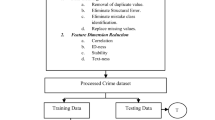Abstract
Crime has negatively impacted the individual’s life and the nation’s economic growth. Currently, manual human assessments are used by security operatives to analyze the relationship between crime location and crime types from huge crime datasets, which are tedious and overwhelming. Hence, subject the criminal prediction results to errors. While many researchers make use of static crime dataset features for prediction which affects the prediction results, fewer approaches have focused on using crime dynamic features to address this lacuna. This research develops a machine learning-ensemble model based on dynamic crime features to address the issue of inaccuracy affecting crime prediction systems. Experiments were conducted on an Africa-based police crime data repository. Based on the experimental results, the proposed model outperforms the state of art models in terms of average precision, F1-score, and accuracy with 0.97, 0.97, and 97.03% respectively. The deployment of this proposed model in a complex environment can help security personnel to solve crime accurately and have a better response towards criminal activities.
Access this chapter
Tax calculation will be finalised at checkout
Purchases are for personal use only
Similar content being viewed by others
References
Esan, O.A., Osunmakinde, I.O.: Towards intelligence vision surveillance for police information systems. In: Silhavy, R. (eds) Cybernetics Perspectives in Systems. CSOC 2022. Lecture Notes in Networks and Systems, vol. 503 (2022). https://doi.org/10.1007/978-3-031-09073-8_13
Felix Enigo, V.S.: An automated system for crime investigation using conventional and machine learning approach. In: Raj, J.S., Bashar, A., Ramson, S.R.J. (eds.) ICIDCA 2019. LNDECT, vol. 46, pp. 109–117. Springer, Cham (2020). https://doi.org/10.1007/978-3-030-38040-3_12
Belesiotis, A., Papadakis, G., Skoutas, D.: Analyzing and predicting spatial crime distribution using crowdsourced and open data. ACM Trans. Spatial Algorithms Syst., 3(4), 12:1–12:31 (2018)
Esan, O.A., Osunmakinde, I.O.: A computer vision model for detecting suspicious behaviour from multiple cameras in crime hotspots using convolutional neural networks. In: Highlights in Practical Applications of Agents, Multi-Agent Systems, and Complex Systems Simulation. The PAAMS Collection. PAAMS 2022. Communications in Computer and Information Science, vol. 1678 (2022). https://doi.org/10.1007/978-3-031-18697-4_16
Khan, M., Ali, A., Alharbi, Y.: Predicting and preventing crime: a crime prediction model using san francisco crime data by classification techniques. Wiley Hindawi 22, 1–13 (2022). https://doi.org/10.1155/2022/4830411
Stalidis, P., Semertzidis, T., Daras, P.: Examining deep learning architectures for crime classification and prediction. Forecasting 3, 741–762 (2021). https://doi.org/10.3390/forecast3040046
Castro, U.R.M., Rodrigues, M.W., Brandao, W.C.: Predicting crimes by exploring supervised learning on heterogenous data. In: Proceedings of the 22nd International Conference on Enterprise Information Systems, vol. 1, pp. 524–531 (2020)
Rajadevi, R., Devi, E.M.R., Kumar, S.V.: Prediction of crime occurrence using multinomial logistic regression. Int. J. Innov. Tech. Exploring Eng. (IJITEE) 3(3), 1432–1435 (2020). https://doi.org/10.35940/ijitee.B7663.019320
S. Wessels, South Africa Crime Dataset (2017). https://www.kaggle.com/slwessels/crime.statistics-for-South-Africa
Yerpude, P., Gudur, V.: Predictive modelling of crime dataset using data mining. Int. J. Data Mining Knowl. Manag. Process (IJDKP) 7(4), 43–58 (2017)
Garton, N., Niemi, J.: Multivariate temporal modeling of crime with dynamic linear models. PLOS ONE 14(7), (2019). https://doi.org/10.1371/journal.pone.0218375
Jacob, B., Lefgren, L., Moretti, E.: The dynamic of criminal behaviour, evidence from weather shocks. J. Hum. Resour. 42(3), 489–527 (2007)
Towers, S., Chen, S., Malik, A., Ebert, D.: Factors influencing temporal patterns in crime in a large American city: a predictive analytics perspective. PLoS ONE 13(10), (2018). https://doi.org/10.1371/journal. pone.0205151
Rumi, S.K., Deng, K., Salim, F.D.: Crime event prediction with dynamic features. EPS Data Sci. 7(43), 1–27 (2018)
Yu, T., Yan, J., Lu, W.: Combining background subtraction and convolutional neural network for anomaly detection in pumping-unit surveillance. Algorithm 12(115), 1–13 (2019). https://doi.org/10.3390/a12060115
S.F.C. dataset, San Francisco Crime Statistics 2005–20015 (2020). https://sfgov.org/crime-statistics
Esan, O.A., Osunmakinde, I.O.: Towards intelligent vision surveillance for police information systems. In: CSOC, Lecturer notes in Networks and Systems, vol. 503 (2022)
Borkin, D., Nemeth, M., Michalconok, G., Mezentseva, O.: Adding additional features to improve time series prediction. Res. Papers Facuty Mater. Sci. Technol. 27(45), 72–78 (2019)
Acknowledgements
The authors acknowledge the financial support made available by the University of South Africa and resources made available by Norfolk University, USA.
Author information
Authors and Affiliations
Editor information
Editors and Affiliations
Rights and permissions
Copyright information
© 2023 The Author(s), under exclusive license to Springer Nature Switzerland AG
About this paper
Cite this paper
Esan, O.A., Osunmakinde, I.O. (2023). Application of Machine Learning in Predicting Crime Links on Specialized Features. In: Neri, F., Du, KL., Varadarajan, V., San-Blas, AA., Jiang, Z. (eds) Computer and Communication Engineering. CCCE 2023. Communications in Computer and Information Science, vol 1823. Springer, Cham. https://doi.org/10.1007/978-3-031-35299-7_12
Download citation
DOI: https://doi.org/10.1007/978-3-031-35299-7_12
Published:
Publisher Name: Springer, Cham
Print ISBN: 978-3-031-35298-0
Online ISBN: 978-3-031-35299-7
eBook Packages: Computer ScienceComputer Science (R0)




